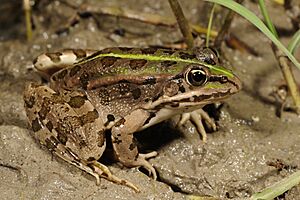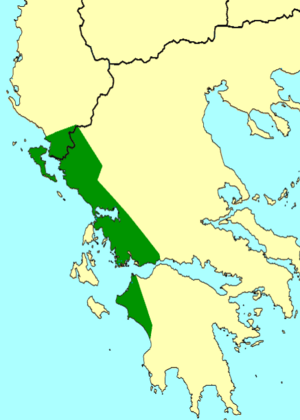Epirus water frog facts for kids
Quick facts for kids Epirus water frog |
|
|---|---|
 |
|
| Conservation status | |
| Scientific classification | |
 |
|
| Synonyms | |
|
The Epirus water frog (scientific name: Pelophylax epeiroticus) is a type of frog that belongs to the Ranidae family. You can find these frogs in western Greece, including an island called Kerkyra, and in the southern parts of Albania. Sometimes, these frogs are caught from nature for people to eat.
What They Look Like
Epirus water frogs are like many other frogs because males and females look a bit different. This is called sexual dimorphism. Male frogs can grow up to about 7.4 centimeters (2.9 inches) long. Female frogs are usually bigger, reaching about 8.4 centimeters (3.3 inches).
Their backs are often green with black spots that are not perfectly shaped. Their bellies are a light color. Male frogs have special sacs on their throats called vocal sacs. These are usually olive green. But during the mating season, they can turn a dark gray color.
Where They Live
You can find Epirus water frogs in places with Mediterranean-style plants and bushes. They live near rivers, swamps, and freshwater lakes and marshes. They also like to live in plantations, which are areas where plants are grown.
Sadly, these frogs are facing threats. Their homes are being lost, which is called habitat loss. Because of this, the Epirus water frog is listed as a vulnerable animal. Their populations are also split up into smaller groups across their living areas.
Reproduction and Life Cycle
The Epirus water frogs lay their eggs from late April to early May. The exact time can change a little. It depends on how high up they live and the local weather.
When many frogs are ready to reproduce, the males start making calls in the morning, around 9 a.m. They keep calling until midnight or even later. They take a break around sunset to catch insects. These frogs have been seen calling when the water temperature is between 13 and 24.5 degrees Celsius.
How They Call
The calls of the Epirus water frog sound a bit creaky. This is because they are made of very short bursts of sound with small pauses in between.
Scientists have studied these calls. At a water temperature of 15 degrees Celsius, a call lasts about 616 milliseconds. It is made up of 32 short sound pulses. When the water gets warmer, the calls become shorter. However, the number of sound pulses in each call actually increases. The sound of their calls is strongest between 1400 and 2400 Hertz. Male frogs usually make these calls in a series, one after another.


